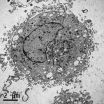(Press-News.org) Chemical modifications to DNA's packaging -- known as epigenetic changes -- can activate or repress genes involved in autism spectrum disorders (ASDs) and early brain development, according to a new study to be published in the journal Nature on Dec. 18.
Biochemists from NYU Langone Medical Center found that these epigenetic changes in mice and laboratory experiments remove the blocking mechanism of a protein complex long known for gene suppression, and transitions the complex to a gene activating role instead.
Researchers say their findings represent the first link between this role reversal and the presence of an important protein whose encoding gene -- autism susceptibility candidate gene 2 or AUTS2 -- has long been tied to ASDs. They also say their study offers a novel theory about how ASDs develop through widespread unraveling of traditional brain pathways.
Specifically, researchers showed that AUTS2 converts polycomb repressive complex 1 (PRC1) -- one of a group of proteins involved in transcriptional regulation during development -- to a gene-activating role, during which it prevents a chemical modification change to histone H2A, a main DNA-packaging protein in all cells with a nucleus.
According to senior study investigator Danny Reinberg, PhD, a professor at NYU School of Medicine and a Howard Hughes Medical Institute investigator, his team's latest findings "offer strong supporting evidence that if ASDs can be tied to widespread disruption of gene networks from multiple genetic lesions, then finding potential therapies could rest on research into repairing these gene network interruptions."
Among the study's other key findings, researchers found that disrupting the function of AUTS2 in mice led to behaviors that were comparable to the neurologically delayed autistic behaviors observed in people. Researchers have already estimated that nearly half of all people with AUTS2 mutations have been diagnosed with some form of the syndrome.
Additional experiments found that AUTS2 proteins were dominant in the cortex region of the mouse brain -- the part of the brain involving memory, attention, and learning -- and were more present in the first few weeks of life than after mice reach adulthood.
To further affirm their findings on the role of AUTS2 in controlling the syndrome, researchers genetically interrupted AUTS2 expression in mice and measured behavioral and motor-reflex effects. Mice with disrupted AUTS2 were slow to react, taking twice as long to right themselves after being placed on their backs, and making fewer than half as many calls after their mothers were taken away, than mice whose AUTS2 production was not impaired. Most AUTS2-deficient mice were also significantly shorter and had lower birth weights than mice producing AUTS2.
Reinberg, whose earlier research in 2012 helped differentiate among various polycomb repressive complexes, also says the new findings point to AUTS2 as a "master regulator" controlling a key transcriptional program during early brain development.
Researchers began the latest study after unexpectedly recording some AUTS2 protein interaction with PRC1 while trying to better define all the PRC1 complexes.
Reinberg's team plans further study of AUTS2 and its activities in other parts of the brain to uncover other possible links to ASDs or other neurological conditions, such as attention deficit hyperactivity disorder (ADHD) and schizophrenia.
INFORMATION:
Funding support for the study was provided by National Institutes of Health grants R01 GM64844. 1DP2 MH100012-01, 5T32 CA160002-03, IF32 GM105275-01A1, and F32 AA022842. Additional funding support came from the Howard Hughes Medical Institute, the Simons Foundation Autism Research Initiative, and the Brain and Behavioral Research Fund Young Investigator Award.
Besides Reinberg, other NYU Langone researchers involved in these experiments were lead study investigators Zhonghua Gao, PhD; Pedro Lee, PhD; and James Stafford, PhD. Additional research support was provided by Anne Schaefer, MD, PhD, and Melanie von Schimmelmann, PhD, at Mount Sinai School of Medicine, also in New York.
For more information, go to:
http://www.med.nyu.edu/ReinbergLab/HTML/Lab.html
http://www.nature.com/nature/journal/vaop/ncurrent/abs/nature13605.html
Media Contacts:
David March
212 .404.3528│david.march@nyumc.org
LA JOLLA, CA--December 17, 2014--Chemists at The Scripps Research Institute (TSRI) have invented a powerful method for joining complex organic molecules that is extraordinarily robust and can be used to make pharmaceuticals, fabrics, dyes, plastics and other materials previously inaccessible to chemists.
"We are rewriting the rules for how one thinks about the reactivity of basic organic building blocks, and in doing so we're allowing chemists to venture where none has gone before," said Phil S. Baran, the Darlene Shiley Chair in Chemistry at TSRI, whose laboratory reports ...
Johns Hopkins and University of Alberta researchers have identified a single protein as the root of painful and dangerous allergic reactions to a range of medications and other substances. If a new drug can be found that targets the problematic protein, they say, it could help smooth treatment for patients with conditions ranging from prostate cancer to diabetes to HIV. Their results appear in the journal Nature on Dec. 17.
Previous studies traced reactions such as pain, itching and rashes at the injection sites of many drugs to part of the immune system known as mast ...
Researchers found 53 existing drugs that may keep the Ebola virus from entering human cells, a key step in the process of infection, according to a study led by researchers at the Icahn School of Medicine at Mount Sinai and the National Institutes of Health (NIH), and published today in the Nature Press journal Emerging Microbes and Infections.
Among the better known drug types shown to hinder infection by an Ebola virus model: several cancer drugs, antihistamines and antibiotics. Among the most effective at keeping the virus out of human cells were microtubule inhibitors ...
Researchers from Intermountain Medical Center in Salt Lake City have identified a new "sliding scale" model used to rule out potentially deadly blood clots in the lungs, known as pulmonary embolisms, that is more accurate than current diagnostic methods.
The new model, which factors in a patient's age, more accurately identifies a patient's risk of the often-deadly blood clots and can more easily rule out the need for additional, more invasive tests, helping to reduce unnecessary costs.
The research is published in the medical journal, CHEST.
Pulmonary embolism is ...
The engineered spring flood that brought water to previously dry reaches of the lower Colorado River and its delta resulted in greener vegetation, the germination of new vegetation along the river and a temporary rise in the water table, according to new results from the binational team of scientists studying the water's effects.
The experimental pulse flow of water was the result of a U.S.-Mexico agreement called Minute 319.
"The pulse flow worked," said Karl W. Flessa, co-chief scientist for the Minute 319 Science Team. "A small amount of water can have a big effect ...
New research helps explain a paradoxical effect of certain antidepressants--that they may actually worsen symptoms before helping patients feel better. The findings, highlighted in a paper publishing online December 17 in the Cell Press journal Trends in Cognitive Sciences, may help investigators fix the problem as well as create new classes of drugs to treat depression.
Selective serotonin reuptake inhibitors (SSRIs) are the most widely prescribed class of antidepressant drugs, and they work by increasing levels of a brain chemical called serotonin. While this boost ...
In an article to be published in the January issue of BioScience, two philosophers tackle one of the most divisive arguments in modern biology: the value of the theory of "kin selection."
Kin selection is the idea that because genes influence behavior, and because an animal that helps its relatives helps to spread genes likely identical to its own, animals will evolve to favor kin. Researchers have spent decades testing this explanation for apparent animal altruism, but in recent years, critics, notably Martin Nowak of Harvard University and the famous naturalist and ...
(PHILADELPHIA) - Researchers look to understand the causes of amyotrophic lateral sclerosis (ALS), in the hope of finding new ways to treat the disease. A new study published online today (December 17th) in the Cell Press journal Neuron shows that a common gene mutation in ALS generates a deadly protein that may cause the damage in the brain that leads to ALS.
About 5 percent of ALS patients carry an altered version of a gene called C9orf72, which in ALS patients contains hundreds of repeat sequences that otherwise are not present in normal individuals. Since the gene's ...
When faced with making choices, but lack sufficient evidence to guarantee success, our brain uses elapsed time as a proxy for task difficulty to calculate how confident we should be, a team of neuroscientists has found. Their findings, which appear in the journal Neuron, help untangle the different factors that contribute to the decision-making process.
"In our daily lives, we make many decisions," says Roozbeh Kiani, an assistant professor in NYU's Center for Neural Science and one of the study's authors. "Sometimes the evidence afforded us is strong, enabling us to ...
More than 90 percent of cancer-related deaths are caused by the spread of cancer cells from their primary tumor site to other areas of the body. A new study has identified how one important gene helps cancer cells break free from the primary tumor.
A gene normally involved in the regulation of embryonic development can trigger the transition of cells into more mobile types that can spread without regard for the normal biological controls that restrict metastasis, the new study shows.
Analysis of downstream signaling pathways of this gene, called SNAIL, could be used ...



